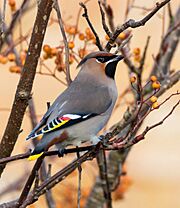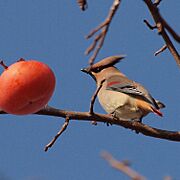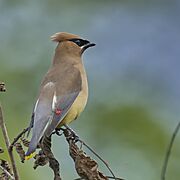Waxwing facts for kids
Quick facts for kids Waxwings |
|
|---|---|
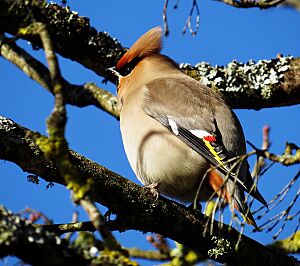 |
|
| Bohemian waxwing (Bombycilla garrulus) | |
| Scientific classification |
|
| Kingdom: | Animalia |
| Phylum: | Chordata |
| Class: | Aves |
| Clade: | Psittacopasserae |
| Order: | Passeriformes |
| Suborder: | Passeri |
| Family: | Bombycillidae William Swainson, 1831 |
| Genus: | Bombycilla Vieillot, 1808 |
| Type species | |
| Bombycilla cedrorum |
|
| Species | |
Waxwings are three special kinds of passerine birds. They belong to a group called Bombycilla. These birds are known for their pretty pinkish-brown and pale grey feathers. They have a smooth look because many of their feathers lie very flat. You can spot them by their black and white stripe around the eye, a cool crest on their head, a square-shaped tail, and pointed wings.
Some of their wing feathers have bright red tips. These tips look a lot like the red wax used to seal old letters. This is how these birds got their common name: "waxwings"! There are three main types of waxwings: the Bohemian waxwing (B. garrulus), the Japanese waxwing (B. japonica), and the cedar waxwing (B. cedrorum).
Waxwings don't fly super long distances like some other birds. Instead, they move around a lot to find food, especially when it's not breeding season. They mostly eat insects in the summer and tasty fruits in the winter. If fruits and insects are hard to find, they might also snack on tree sap, buds, and flowers. They are clever hunters, catching insects by looking through leaves or even grabbing them right out of the air! They often build their nests near water. The female builds a loose nest in a tree branch, away from the main trunk. She also sits on the eggs to keep them warm. The male brings her food, and both parents help take care of the baby birds.
Contents
Discovering Waxwings: Their Place in Nature
Waxwings are so unique that they are the only birds in their special family, called Bombycillidae. Long ago, some other birds were thought to be part of this family. These included birds like silky-flycatchers and palm chats. But now, scientists have learned more. They have given these other birds their own families. Still, all these bird groups are related and belong to a larger group called Bombycilloidea.
Meet the Waxwing Species
There are three main types of waxwings you can find around the world:
| Common name | Scientific name and subspecies | Range | Size and ecology | IUCN status and estimated population |
|---|---|---|---|---|
| Bohemian waxwing | Bombycilla garrulus {{{authority-name}}}, {{{authority-year}}} |
northern regions of Eurasia and North America. |
Size: {{{size}}} Habitat: {{{habitat}}} Diet: {{{hunting}}} |
LC
|
| Japanese waxwing | Bombycilla japonica {{{authority-name}}}, {{{authority-year}}} |
Breeding in the Russian Far East and Heilongjiang Province, north-east China, Wintering in Japan, Korea, and eastern China | Size: {{{size}}} Habitat: {{{habitat}}} Diet: {{{hunting}}} |
NT
|
| Cedar waxwing | Bombycilla cedrorum {{{authority-name}}}, {{{authority-year}}} |
United States, Mexico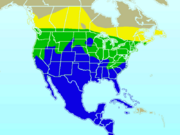 |
Size: {{{size}}} Habitat: {{{habitat}}} Diet: {{{hunting}}} |
LC
|
- LC means "Least Concern." This means the species is not currently at risk of disappearing.
- NT means "Near Threatened." This means the species might become at risk in the future.
What's in a Name?
The scientific name for the waxwing group is Bombycilla. This name was created by a scientist named Louis Pierre Vieillot. He tried to make a Latin word that meant "silktail." He thought the German name for these birds, Seidenschwänze, meant "silktail." So, he combined the Latin word bombyx, which means silk, with part of another bird's name, motacilla. He thought cilla meant "tail." It's a bit of a mix-up, but the name stuck!
What Do Waxwings Look Like?
Waxwings have very soft, silky feathers. A special feature is the red tips on some of their wing feathers. These tips look just like drops of red sealing wax. This is where their common name comes from! You can see these red tips best on adult Bohemian and Cedar waxwings. Japanese waxwings sometimes don't have them, and young birds of the other two species might not either.
Their legs are short but strong. Their wings are pointed, which helps them fly. Both male and female waxwings look very similar. All three species are mostly pale grey-brown. They have a black line through their eye and a black patch under their chin. Their tails are square-ended and have a red or yellow tip. They also have a cool, pointed crest on their heads. Their beaks, eyes, and feet are dark, almost black.
Adult waxwings change their feathers, a process called moulting, between August and November. Sometimes, they might pause this process and finish it after they have moved to their winter homes. Their calls are high-pitched sounds. They often sound like buzzing or trilling noises.
Waxwing Life and Habits
What Do Waxwings Eat?
Waxwings are birds that love to live in trees. They build their nests in the northern taiga forests. Their diet changes with the seasons. In spring and summer, they mainly eat insects. They will also eat insects at other times if they can find them. From early summer through autumn and winter, they feast on fruits. They enjoy strawberries, mulberries, cherries, raspberries, and many kinds of berries like rowan and juniper. The juicy berries from rowan trees are especially important to them.
They pick fruit while sitting on a branch. Sometimes, they even hover in the air to grab a berry! In spring, when fruits are scarce, they might drink tree sap or eat buds and flowers. During warmer months, they catch many insects. They find insects by looking through leaves or by flying out to catch them in mid-air. They often nest near water because there are lots of flying insects there.
The Waxwing Life Cycle: Nesting and Young
Waxwings are smart about where they nest. They choose places with plenty of fruit. They also start breeding later in the year to make sure there's lots of summer fruit for their babies. However, they might begin their courtship rituals as early as winter.
Their courtship involves a special dance. A male and female will pass a fruit or a small object back and forth several times. Eventually, one of them will eat the fruit. After this, they might mate. Many waxwing pairs might nest close together if there's a lot of food. They don't usually defend a large area of land, which is why they don't have a complex song. However, a bird might chase away other birds to protect its mate.
Both the male and female gather materials for the nest. But the female does most of the building. She usually builds a loose, bulky nest. It's made of twigs, grass, and lichen. She lines the inside with soft grass, moss, and pine needles. She might even decorate it with dangling pieces of grass or flowers to help hide it. The nest is often built on a horizontal branch or in a fork of a branch, far from the tree trunk.
The female sits on the eggs to keep them warm. The male brings her food while she is on the nest. Once the eggs hatch, both parents work together to feed and care for their young.
Waxwing Journeys: Migration
Waxwings are not considered true long-distance migrants. This means they don't travel thousands of miles every year like some birds. Instead, they wander around outside of their breeding season. They move south from their summer homes when winter arrives.
In years when there aren't many berries, huge numbers of waxwings might travel much farther than usual. These large movements are called "irruptions." During these times, you might see hundreds or even thousands of waxwings together, all looking for food.
See also
 In Spanish: Bombycilla para niños
In Spanish: Bombycilla para niños


